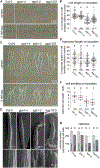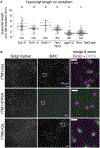A G protein-coupled receptor-like module regulates cellulose synthase secretion from the endomembrane system in Arabidopsis
- PMID: 33878345
- PMCID: PMC8754689
- DOI: 10.1016/j.devcel.2021.03.031
A G protein-coupled receptor-like module regulates cellulose synthase secretion from the endomembrane system in Arabidopsis
Abstract
Cellulose is produced at the plasma membrane of plant cells by cellulose synthase (CESA) complexes (CSCs). CSCs are assembled in the endomembrane system and then trafficked to the plasma membrane. Because CESAs are only active in the plasma membrane, control of CSC secretion regulates cellulose synthesis. We identified members of a family of seven transmembrane domain-containing proteins (7TMs) that are important for cellulose production during cell wall integrity stress. 7TMs are often associated with guanine nucleotide-binding (G) protein signaling and we found that mutants affecting the Gβγ dimer phenocopied the 7tm mutants. Unexpectedly, the 7TMs localized to the Golgi/trans-Golgi network where they interacted with G protein components. Here, the 7TMs and Gβγ regulated CESA trafficking but did not affect general protein secretion. Our results outline how a G protein-coupled module regulates CESA trafficking and reveal that defects in this process lead to exacerbated responses to cell wall integrity stress.
Keywords: G protein-coupled receptor; GPCR; cell wall signaling; cellulose; cellulose synthesis; plant cell biology; plant cell walls; secretion.
Copyright © 2021 Elsevier Inc. All rights reserved.
Conflict of interest statement
Declaration of interests The authors declare no competing interests.
Figures







Similar articles
-
CESA TRAFFICKING INHIBITOR inhibits cellulose deposition and interferes with the trafficking of cellulose synthase complexes and their associated proteins KORRIGAN1 and POM2/CELLULOSE SYNTHASE INTERACTIVE PROTEIN1.Plant Physiol. 2015 Feb;167(2):381-93. doi: 10.1104/pp.114.249003. Epub 2014 Dec 22. Plant Physiol. 2015. PMID: 25535279 Free PMC article.
-
Golgi-localized STELLO proteins regulate the assembly and trafficking of cellulose synthase complexes in Arabidopsis.Nat Commun. 2016 Jun 9;7:11656. doi: 10.1038/ncomms11656. Nat Commun. 2016. PMID: 27277162 Free PMC article.
-
TRANVIA (TVA) facilitates cellulose synthase trafficking and delivery to the plasma membrane.Proc Natl Acad Sci U S A. 2021 Jul 27;118(30):e2021790118. doi: 10.1073/pnas.2021790118. Proc Natl Acad Sci U S A. 2021. PMID: 34290139 Free PMC article.
-
Regulation of cellulose synthesis via exocytosis and endocytosis.Curr Opin Plant Biol. 2022 Oct;69:102273. doi: 10.1016/j.pbi.2022.102273. Epub 2022 Aug 17. Curr Opin Plant Biol. 2022. PMID: 35987011 Review.
-
The trafficking of the cellulose synthase complex in higher plants.Ann Bot. 2014 Oct;114(6):1059-67. doi: 10.1093/aob/mcu040. Epub 2014 Mar 20. Ann Bot. 2014. PMID: 24651373 Free PMC article. Review.
Cited by
-
The damage-associated molecular pattern cellotriose alters the phosphorylation pattern of proteins involved in cellulose synthesis and trans-Golgi trafficking in Arabidopsis thaliana.Plant Signal Behav. 2023 Dec 31;18(1):2184352. doi: 10.1080/15592324.2023.2184352. Plant Signal Behav. 2023. PMID: 36913771 Free PMC article.
-
Actomyosin and CSI1/POM2 cooperate to deliver cellulose synthase from Golgi to cortical microtubules in Arabidopsis.Nat Commun. 2023 Nov 17;14(1):7442. doi: 10.1038/s41467-023-43325-9. Nat Commun. 2023. PMID: 37978293 Free PMC article.
-
The cell biology of primary cell walls during salt stress.Plant Cell. 2023 Jan 2;35(1):201-217. doi: 10.1093/plcell/koac292. Plant Cell. 2023. PMID: 36149287 Free PMC article. Review.
-
NKS1/ELMO4 is an integral protein of a pectin synthesis protein complex and maintains Golgi morphology and cell adhesion in Arabidopsis.Proc Natl Acad Sci U S A. 2024 Apr 9;121(15):e2321759121. doi: 10.1073/pnas.2321759121. Epub 2024 Apr 5. Proc Natl Acad Sci U S A. 2024. PMID: 38579009 Free PMC article.
-
Membrane nanodomains to shape plant cellular functions and signaling.New Phytol. 2025 Feb;245(4):1369-1385. doi: 10.1111/nph.20367. Epub 2024 Dec 25. New Phytol. 2025. PMID: 39722237 Free PMC article. Review.
References
-
- Anderson CT, and Kieber JJ (2020). Dynamic Construction, perception, and remodeling of plant cell walls. Annu. Rev. Plant Biol 71, 39–69. - PubMed
-
- Anderson DJ, and Botella JR (2007). Expression analysis and subcellular localization of the Arabidopsis thaliana G-protein beta-subunit AGB1. Plant Cell Rep. 26, 1469–1480. - PubMed
-
- Aranda-Sicilia MN, Trusov Y, Maruta N, Chakravorty D, Zhang Y, and Botella JR (2015). Heterotrimeric G proteins interact with defense-related receptor-like kinases in Arabidopsis. J. Plant Physiol 188, 44–48. - PubMed
-
- Arioli T, Peng L, Betzner AS, Burn J, Wittke W, Herth W, Camilleri C, Höfte H, Plazinski J, Birch R, et al. (1998). Molecular analysis of cellulose biosynthesis in Arabidopsis. Science 279, 717–720. - PubMed
Publication types
MeSH terms
Substances
Grants and funding
LinkOut - more resources
Full Text Sources
Other Literature Sources
Molecular Biology Databases

